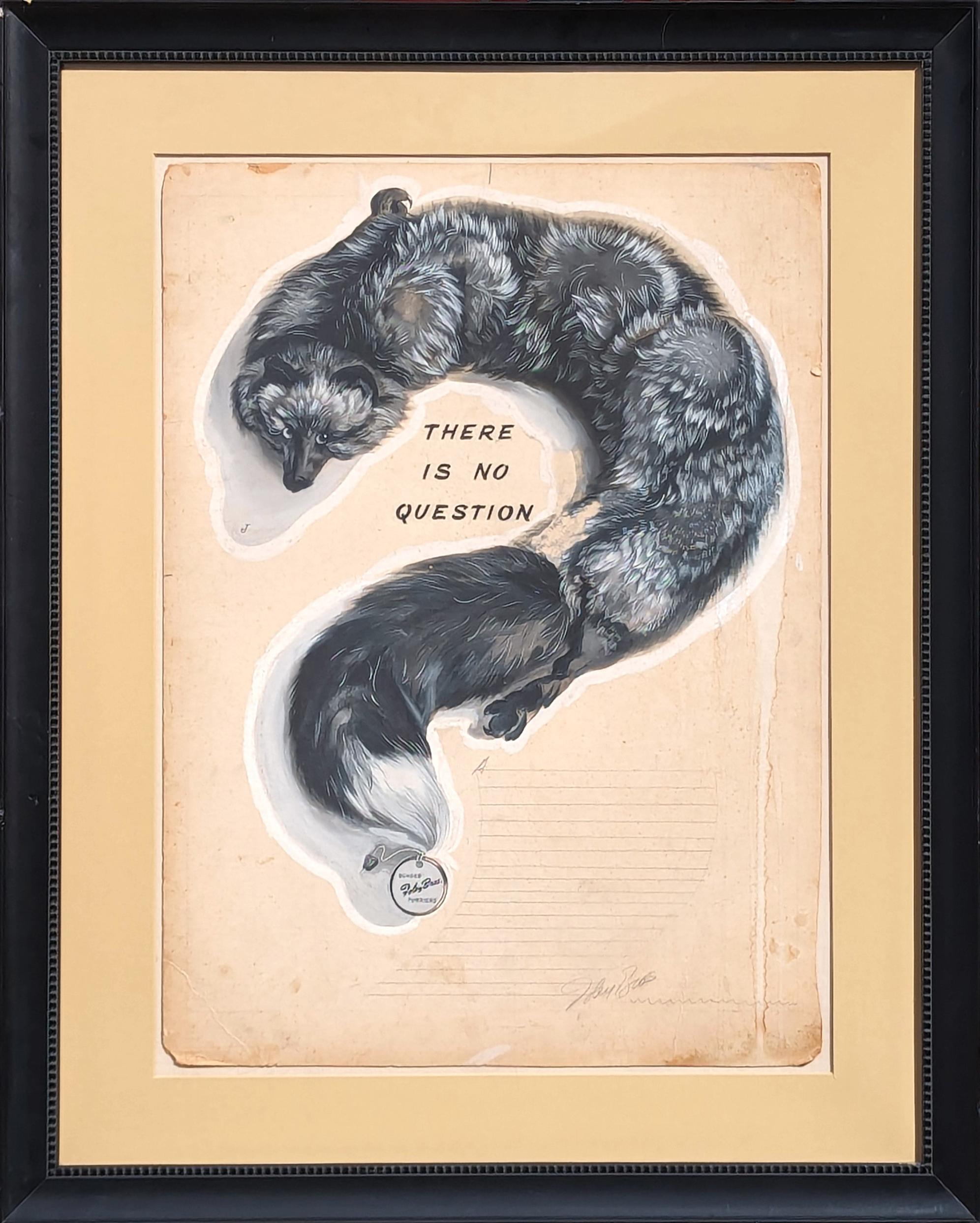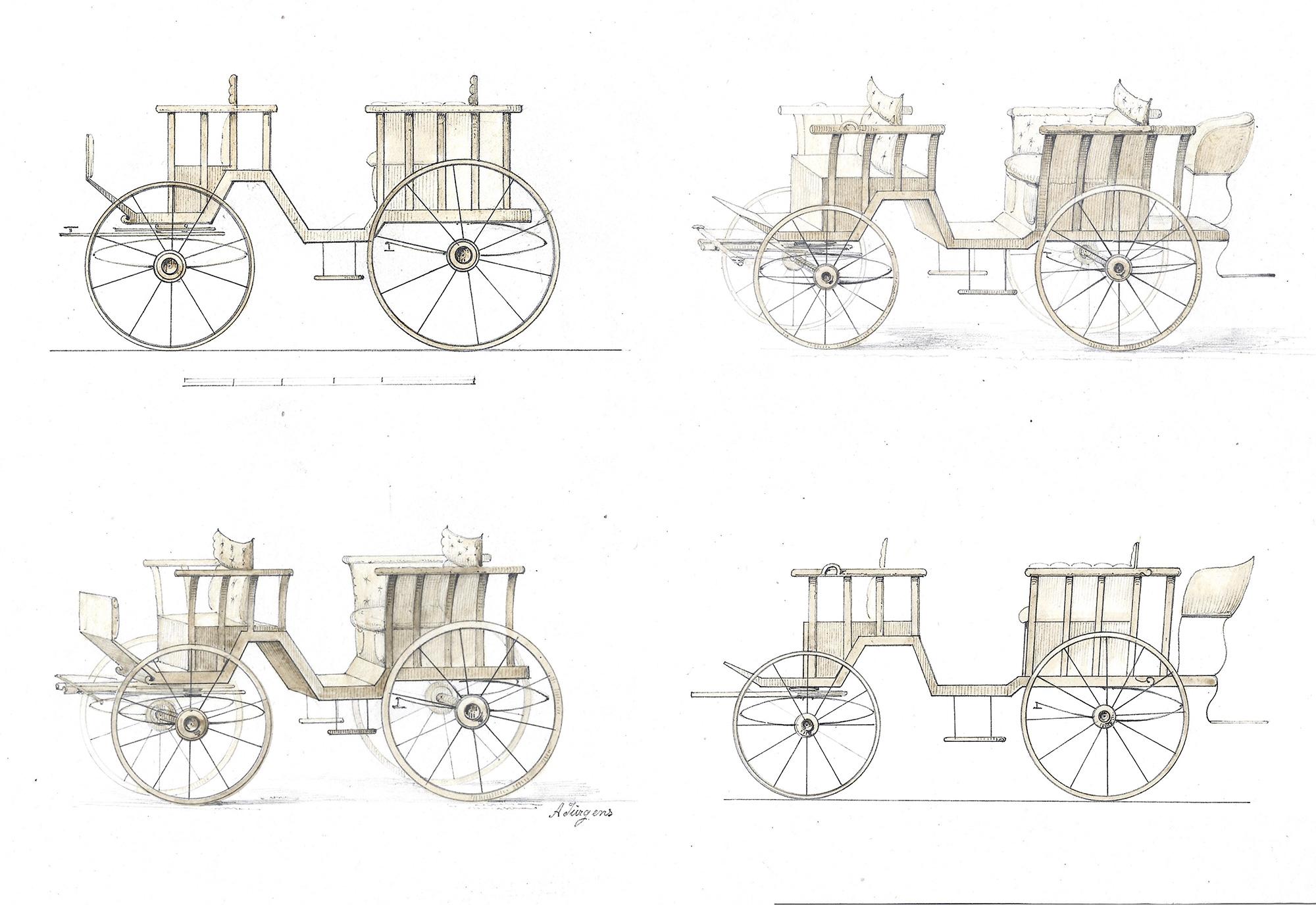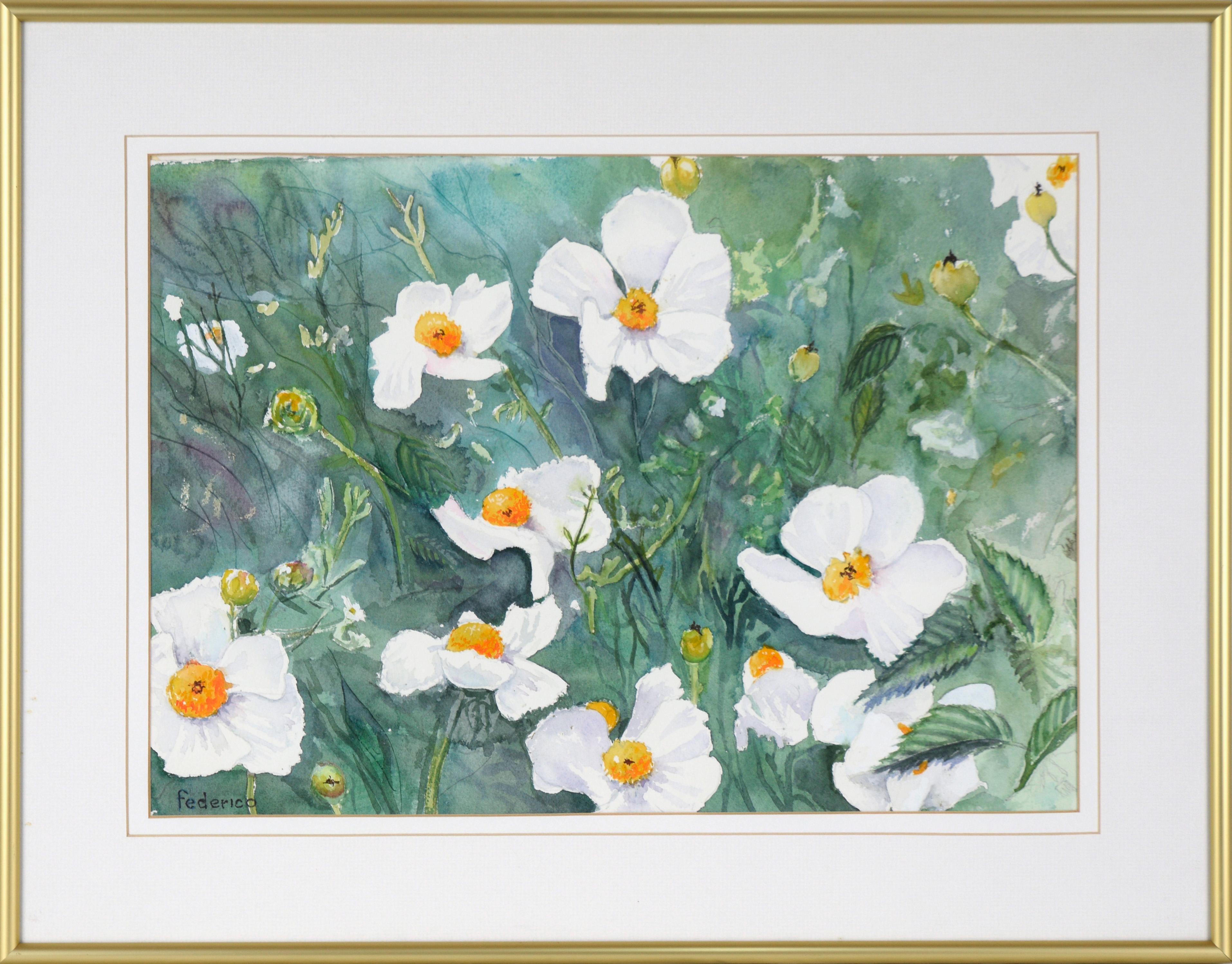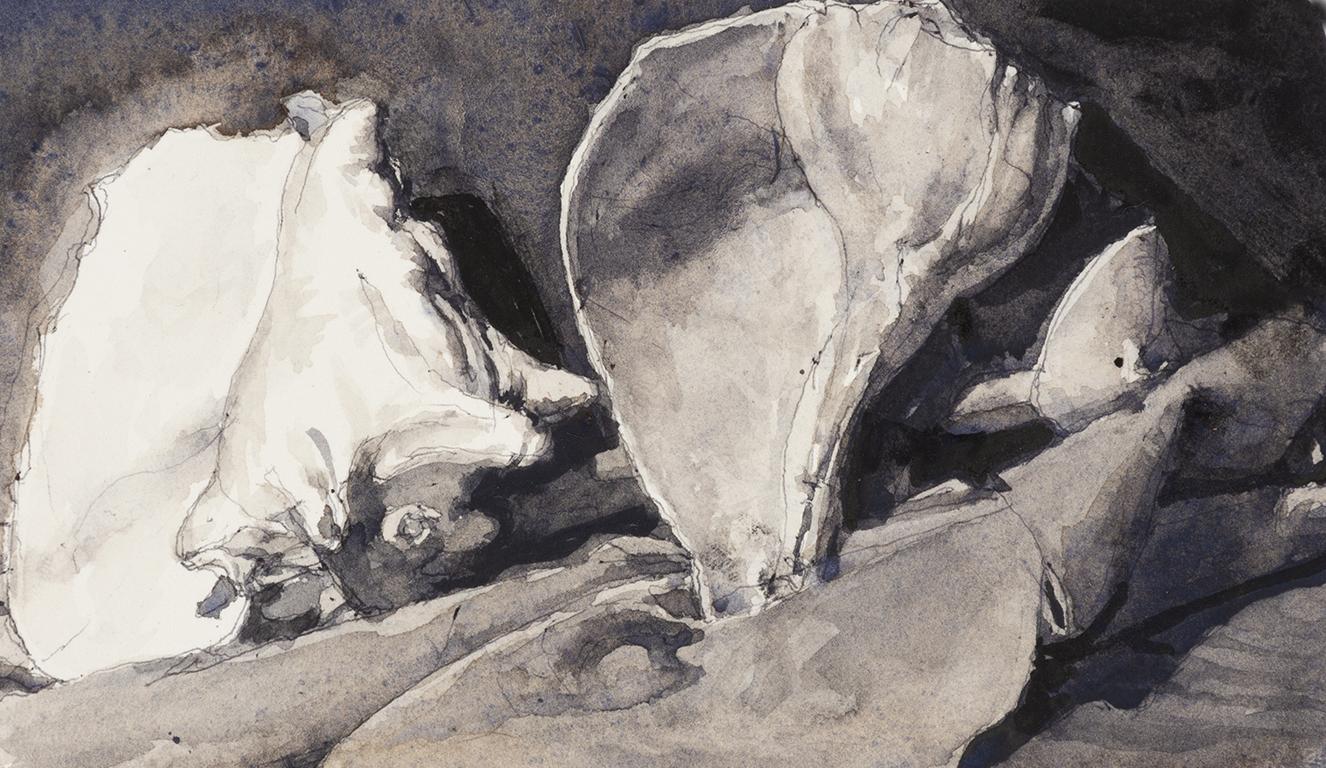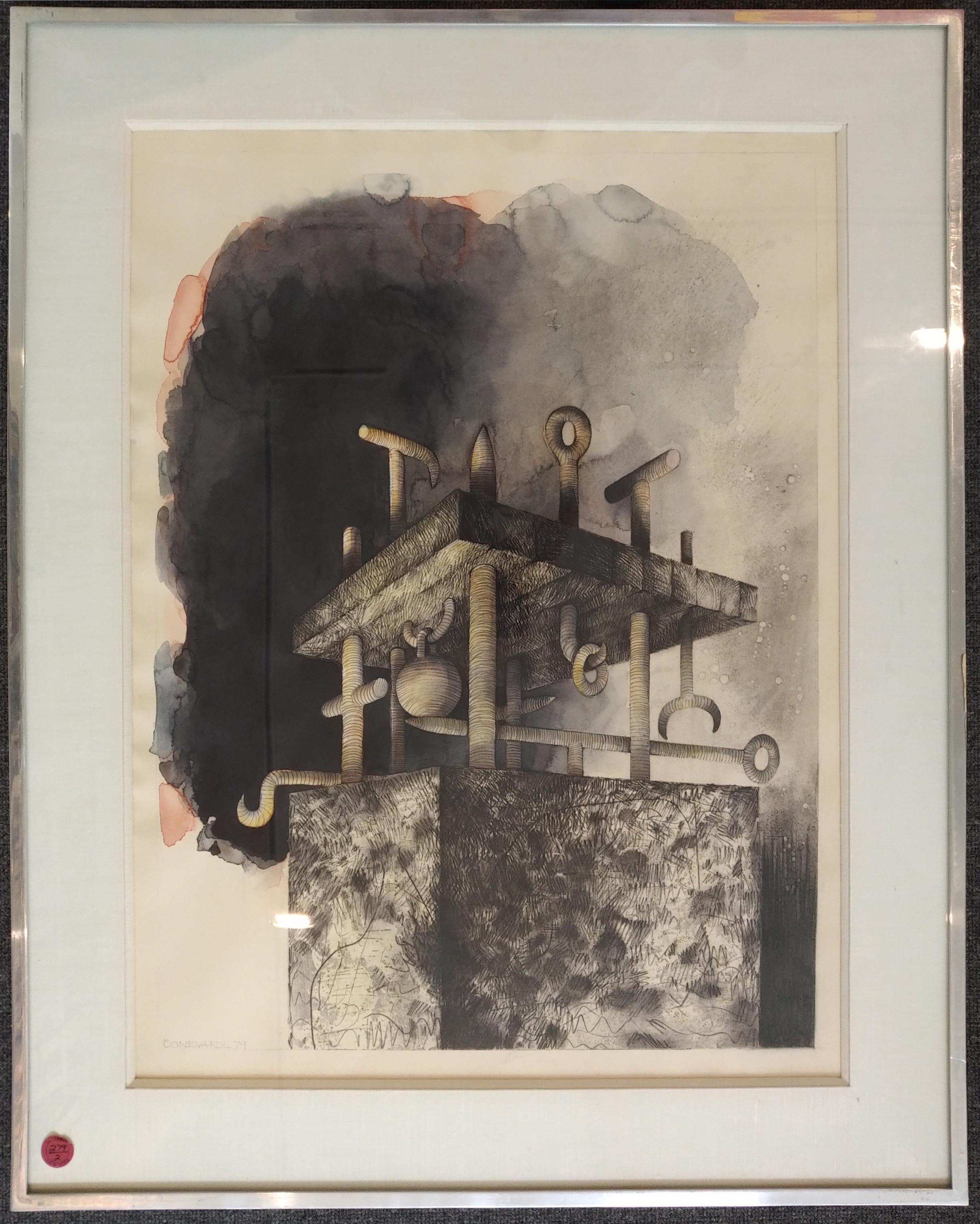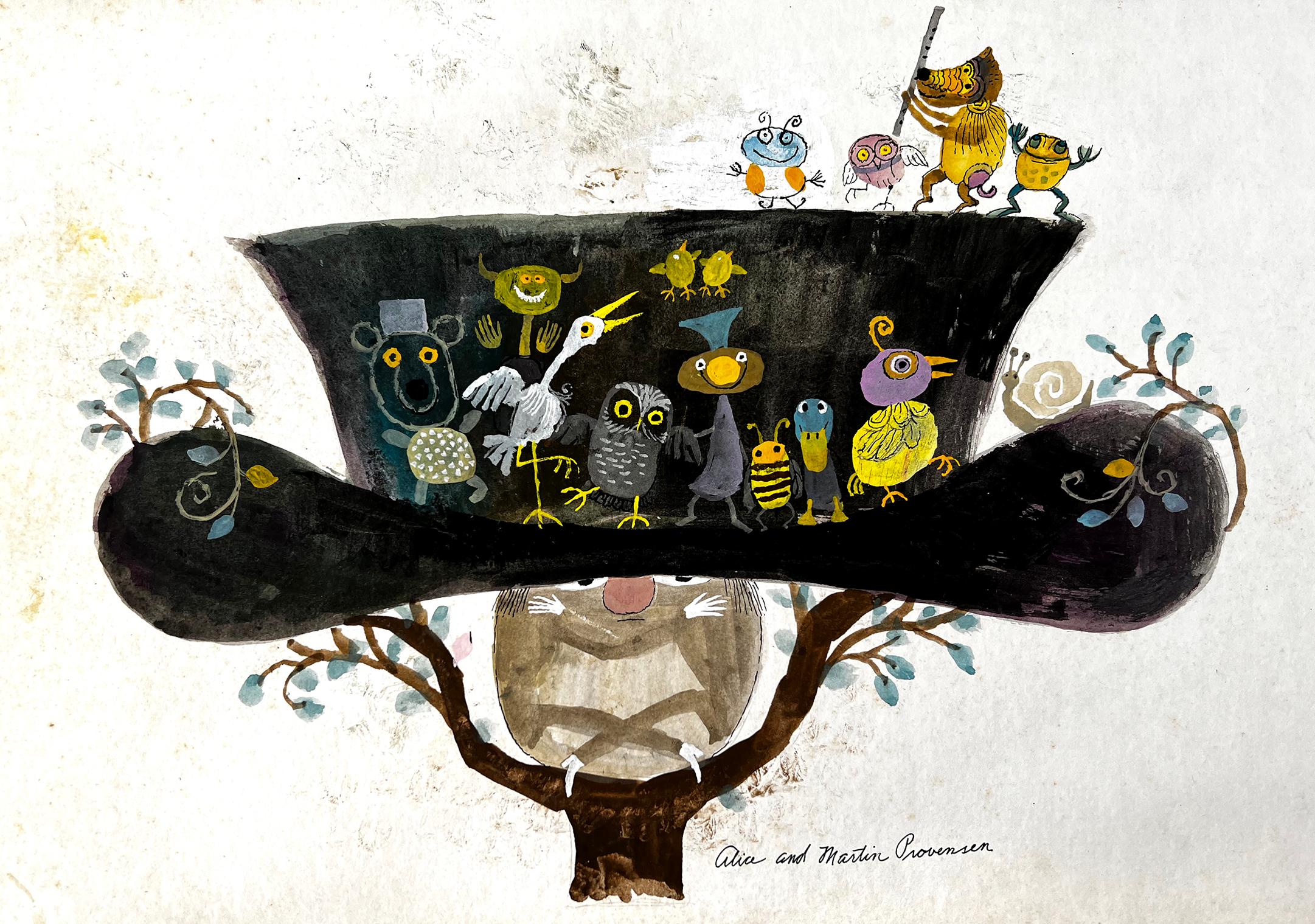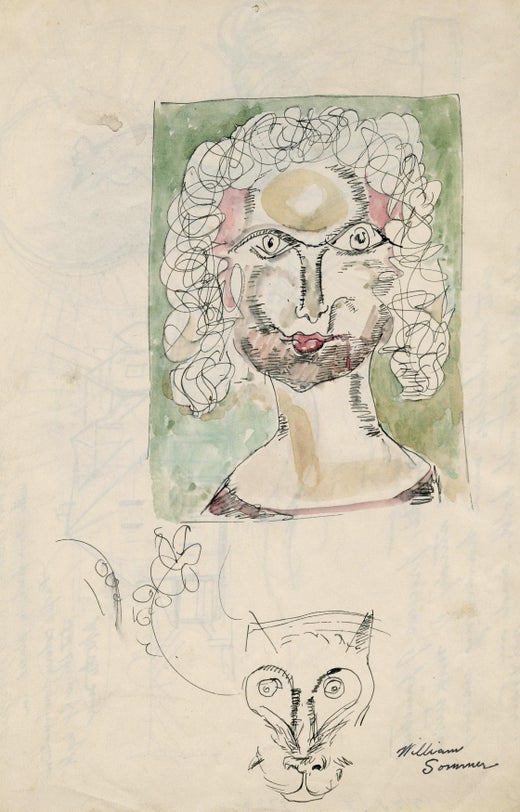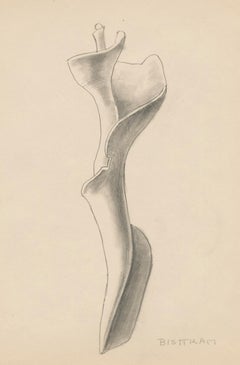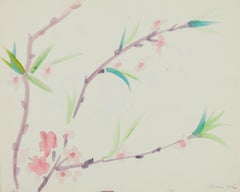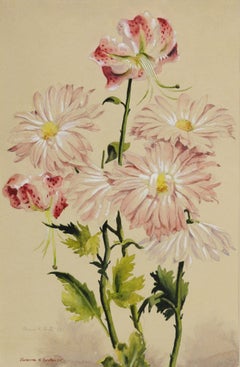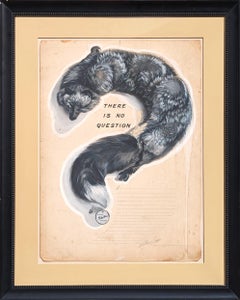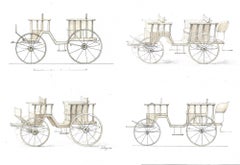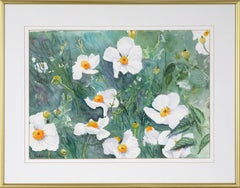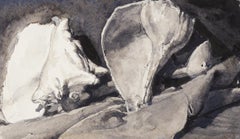Items Similar to Still Life with Tromp L'Oeil
Want more images or videos?
Request additional images or videos from the seller
1 of 11
William SommerStill Life with Tromp L'Oeilc. 1924
c. 1924
About the Item
Still Life with Tromp L'Oeil
Graphite and watercolor on a book page.
Signed in ink by the artist lower right corner
(see photo)
Provenance:
Estate of the artist (Estate No. 00916 verso)
Ray Sommer (the artist's son)
Joseph M. Erdelac (No. 18 JME verso)
Book page verso is an illustration of a Durer woodcut.
William Sommer
(1867-1949)
William Sommer is seen as a key person in bringing European modernism to Northeast Ohio. He was born in Detroit, Michigan, and in his youth apprenticed for seven years to a lithographer.
He briefly studied at an art academy in Germany and then worked as a lithographer in New York before moving to Cleveland, where he was awarded a major contract with the Otis Lithography Company. There he became friends with sculptor and painter William Zorach, and the two, determined to be fine artists, began painting together on weekends. They also became intrigued by avant-garde movements, especially after Zorach's trip to Paris in 1910.
In 1911, Sommer co-founded a group in Cleveland called the Kokoon Club, a mixed group of commercial artists and radical modernists who sought the freedom to pursue their independent tendencies. They converted a tailor's shop into a studio and held exhibitions and lectures and organized an annual masked ball that became the focus of Cleveland's bohemian life.
In 1913, he and his colleagues began painting at Brandywine, about 30 miles south of Cleveland and made a school house into a studio. They devoted increasing time to watercolor painting because they could work spontaneously and it would dry quickly. Rejecting the conventional ideas of beauty, they strove for the expression of emotion and spontaneity and fantasy. One of Sommer's most successful students was Charles Burchfield.
As he was perfecting his mature style, he had financial difficulties because he made his living from commercial lithography, which was becoming obsolete, and the Depression was hitting the nation causing him to lose his job. He became a WPA artist, doing murals in northeastern Ohio.
After his death at age 82, he was largely forgotten until 1980 when Hilton Kramer, a "New York Times" critic, praised his work. In May to July, 1994, the Ohio Arts Council held a retrospective of his work at the Riffe Gallery in Columbus. His work is found in many public collections including the National Museum of American Art, The Metropolitan Museum of Art, and the Whitney Museum of American Art.
Courtesy, AskArt
- Creator:William Sommer (1867-1949, American)
- Creation Year:c. 1924
- Dimensions:Height: 16 in (40.64 cm)Width: 19.25 in (48.9 cm)
- Medium:
- Movement & Style:
- Period:
- Condition:Chipping around the edges. Repaired tears lower corners. Image: 8 1/2 x 11"; Frame: 16 x 19 1/8".
- Gallery Location:Fairlawn, OH
- Reference Number:Seller: FA89451stDibs: LU14015021472
William Sommer
William Sommer is seen as a key person in bringing European modernism to Northeast Ohio. He was born in Detroit, Michigan, and in his youth apprenticed for seven years to a lithographer. He briefly studied at an art academy in Germany and then worked as a lithographer in New York before moving to Cleveland, where he was awarded a major contract with the Otis Lithography Company. There he became friends with sculptor and painter William Zorach, and the two, determined to be fine artists, began painting together on weekends. They also became intrigued by avant-garde movements, especially after Zorach's trip to Paris in 1910. In 1911, Sommer co-founded a group in Cleveland called the Kokoon Club, a mixed group of commercial artists and radical modernists who sought the freedom to pursue their independent tendencies. They converted a tailor's shop into a studio and held exhibitions and lectures and organized an annual masked ball that became the focus of Cleveland's bohemian life. In 1913, he and his colleagues began painting at Brandywine, about 30 miles south of Cleveland and made a school house into a studio. They devoted increasing time to watercolor painting because they could work spontaneously and it would dry quickly. Rejecting the conventional ideas of beauty, they strove for the expression of emotion and spontaneity and fantasy. One of Sommer's most successful students was Charles Burchfield. As he was perfecting his mature style, he had financial difficulties because he made his living from commercial lithography, which was becoming obsolete, and the Depression was hitting the nation causing him to lose his job. He became a WPA artist, doing murals in northeastern Ohio. After his death at age 82, he was largely forgotten until 1980 when Hilton Kramer, a "New York Times" critic, praised his work. In May to July, 1994, the Ohio Arts Council held a retrospective of his work at the Riffe Gallery in Columbus. His work is found in many public collections including the National Museum of American Art, The Metropolitan Museum of Art, and the Whitney Museum of American Art.
About the Seller
5.0
Recognized Seller
These prestigious sellers are industry leaders and represent the highest echelon for item quality and design.
Platinum Seller
Premium sellers with a 4.7+ rating and 24-hour response times
Established in 1978
1stDibs seller since 2013
784 sales on 1stDibs
Typical response time: 1 hour
Associations
International Fine Print Dealers Association
- ShippingRetrieving quote...Shipping from: Fairlawn, OH
- Return Policy
Authenticity Guarantee
In the unlikely event there’s an issue with an item’s authenticity, contact us within 1 year for a full refund. DetailsMoney-Back Guarantee
If your item is not as described, is damaged in transit, or does not arrive, contact us within 7 days for a full refund. Details24-Hour Cancellation
You have a 24-hour grace period in which to reconsider your purchase, with no questions asked.Vetted Professional Sellers
Our world-class sellers must adhere to strict standards for service and quality, maintaining the integrity of our listings.Price-Match Guarantee
If you find that a seller listed the same item for a lower price elsewhere, we’ll match it.Trusted Global Delivery
Our best-in-class carrier network provides specialized shipping options worldwide, including custom delivery.More From This Seller
View AllUntitled, Still Life of Shell
Located in Fairlawn, OH
Untitled, Still Life of Shell
Graphite on paper, 1945-1951
Signed lower right in pencil "Bisttram" (see photo)
Condition: Excellent
Sheet size: 9.63 x 7 .5 inches
EMIL BISTTRAM (189...
Category
1940s American Modern Still-life Drawings and Watercolors
Materials
Graphite
Plum Branches and Flowers
By Joseph O'Sickey
Located in Fairlawn, OH
Plum Branches and Flowers
watercolor on wove paper, 1985
Signed and dated in pencil lower right corner
From the artist's 1985 sketchbook
Inspired by O'Sickey's love of Japanese and Chinese art and calligraphy.
Provenance: Estate of the artist
Condition: Excellent
Image/Sheet size: 13 5/8 x 17 inches
Joseph B. O’Sickey, Painter
1974 CLEVELAND ARTS PRIZE FOR VISUAL ARTS
The title conferred on him by Plain Dealer art critic Steve Litt in a 1994 article, “the dean of painting in northeast Ohio,” must have pleased Joseph O'Sickey. It was more than 30 years since he had burst onto the local (and national) art scene. O’Sickey was already in his 40s in that spring of 1962 when he had his first one-man show at the Akron Art Museum and was signed by New York’s prestigious Seligmann Galleries, founded in 1888. In the decade and a half that followed, he would have seven one-man shows at Seligmann, which had showed the work of such trailblazing figures as Seurat, Vuilliard, Bonnard, Leger and Picasso, and appear in all of the group shows.
O’Sickey took the Best Painting award in the 1962 May Show at the Cleveland Museum of Art (CMA). He and would capture the same honor in back-to-back May Shows in 1964 and ’65, and again in 1967. The remarkable thing, noted the Plain Dealer’s Helen Borsick, was that he accomplished this sweep in a variety of painterly styles, even using that most hackneyed of subjects, flowers. “The subject doesn’t matter,” he told her, “what the artist brings to it is the important thing.” O’Sickey’s garden and landscape paintings were big and bold, eschewing delicate detail in favor of vitality and impact. The great art collector and CMA benefactor Katherine C. White, standing before one of O’Sickey’s vivid garden paintings, compared the sensation to “being pelted with flowers.”
Though he might represent an entire blossom with one or two smudged brush strokes or a stem with a simple sweep of green, O’Sickey rejected the moniker of Impressionist—or Pointillist or Abstract painter or Expressionist. “My work,” he said, “is a direct response to the subject. I believe in fervor and poetic metaphor. I try to make each color and shape visible and identifiable within the context of surrounding colors and shapes. A yellow must hold its unique quality from any another yellow or surrounding color, and yet read as a lemon or an object, by inference. It does not require shading or modeling—the poetic evocation is part of the whole.”
“The subject,” O’Sickey used to tell his students at Kent State University, where he taught painting from 1964 to 1989, “has to be seen as a whole and the painting has to be structured to be seen as a whole.” He liked to think of it as “a process of controlled rapture.”
When, in the 1960s, fond childhood memories drew him to the zoo, he found himself responding to the caged animals in their lonely dignity (or indignity) with sharp-edged, almost silhouette-like forms that evoked Matisse’s paintings and cut-paper assemblages. One observer was left with the impression that the artist had “looked at these animals, past daylight and into dusk when they lose their details in shadow and become pure shapes, with eyes that are seeing the viewer rather than the other way around. This is a world of shape and essence,” wrote Helen Borsick. “All is simplification.”
O’Sickey attributed his ability to capture his subjects with just a few strokes—in an almost iconographic way—to a rigorous exercise he had imposed upon himself over a period of several months. Limiting his tools to a large No. 6 bristle brush and black ink, he set himself the task of drawing his pet parakeet and the other small objects in its cage (cuttlebone, feeding dish, tinkling bell) hundreds of times. The exercise gave him “invaluable insights into painting. . . . Because of the crudity of the medium, every part of these drawings had to be an invention and every mark had to have its room and clarity.” Then he began adding one color at a time—“still with the same brush and striving for the same clarity”—and headed off to the zoo where “the world opened up to me. I learned how little it took to express the subject.”
Born in Detroit at the close of the First World War, O’Sickey grew up in St. Stanislaus parish near East 65th and Fleet on Cleveland’s southeast side. (The apostrophe was inserted into the family’s proud Polish name by a clerk at Ellis Island.) An early interest in drawing and painting may have been kindled by the presence on the walls of Charles Dickens Elementary School, one of only three grade schools in the district with a special focus on the arts, of masterful watercolors by such Cleveland masters as Paul Travis, Frank N. Wilcox and Bill Coombes.
As a youngster O’Sickey took drawing classes at the Cleveland Museum of Art, and he and his brother spent hours copying famous paintings; while a student at East Tech High School in the mid-’30s, he attended free evening classes in life drawing with Travis and Ralph Stoll at the John Huntington Art and Polytechnic Institute, and Saturday classes at the Cleveland School (later the Cleveland Institute) of Art, where he earned his degree in 1940 under the tutelage of Travis, Stoll and such other legendary figures as Henry Keller, Carl Gaertner, William Eastman, Kenneth Bates...
Category
1980s Contemporary Still-life Drawings and Watercolors
Materials
Watercolor
Iris
By Greta Allen
Located in Fairlawn, OH
Iris
Watercolor on paper, c. 1920
Unsigned
Provenance: Estate of the Artist
Condition: Excellent, slight surface dirt
Image/Sheet size: 15 x 10 1/4 inches
Allen was trained in Boston...
Category
20th Century American Impressionist Still-life Drawings and Watercolors
Materials
Watercolor
Chrysanthemums and Tiger Lilies
By Clarence Holbrook Carter
Located in Fairlawn, OH
Chrysanthemums and Tiger Lilies
Signed and dated lower left (twice), see photo
Watercolor on paper, 1935
A symbol of the sun, the Japanese consider the or...
Category
1930s Realist Drawings and Watercolor Paintings
Materials
Watercolor
Homage to Morandi
By Phyllis Sloane
Located in Fairlawn, OH
Homage to Morandi
Watercolor, c. 1990
Signed lower right: Sloane
An important exhibition size watercolor by the artist.
Acquired by the Cleveland Clinic, de-accessed in 2021
Conditio...
Category
1990s Contemporary Still-life Drawings and Watercolors
Materials
Watercolor
untitled (Reclining Female Nude)
By Charles Harris ( Beni Kosh )
Located in Fairlawn, OH
Aka Beni Kosh
Still Life with Flowers
Colored pencil on paper
Unsigned
Signed with the estate stamp on reverse (see photo)
Estate No. 716
Condition: Soft fold through image, wri...
Category
1960s Contemporary Still-life Drawings and Watercolors
Materials
Gouache
You May Also Like
"There is No Question" Early Modern Original Foley's Ad Layout with Mink Stole
Located in Houston, TX
Early modern original watercolor and gouache ad layout for Foley's by Houston portraitist Robert C. Joy. The work features a mink stole laid out in the shape of a question mark. Ther...
Category
Early 20th Century American Modern Animal Drawings and Watercolors
Materials
Watercolor, Gouache
Kutschen (carriages); Group of four designs for hansom cabs.
By Alfred Juergens
Located in Middletown, NY
Four pencil drawings, each with hand coloring in watercolor, each 6 3/4 x 10 inches (sheet) (172 x 254 mm), full margins. Each with inscriptions and notations by the artist in the up...
Category
Mid-20th Century American Modern Still-life Drawings and Watercolors
Materials
Handmade Paper, Watercolor, Pencil
White Poppies - Botanical Watercolor on Paper
Located in Soquel, CA
White Poppies - Botanical Watercolor on Paper
Detailed floral watercolor by Harry Federico (American, 1922-2022). Several white poppies ...
Category
21st Century and Contemporary American Modern Landscape Drawings and Wat...
Materials
Watercolor, Laid Paper
Tribute to Morandi #29
By Bob Stuth-Wade
Located in Dallas, TX
Bob Stuth-Wade: Tribute to Morandi, 2018
"Life is what happens while I'm thinking of something else."
"Driving. Listening to the radio. Talking on the phone. Thinking of where I'm ...
Category
2010s American Modern Still-life Drawings and Watercolors
Materials
Ink, Paper, Watercolor
UNTITLED No. 26
Located in New York, NY
Avant-Garde
Argentine
Category
1970s American Modern Still-life Drawings and Watercolors
Materials
Paper, Pencil, Watercolor, Charcoal, Conté
Price Upon Request
Dancing Animal Critters on a Top Hat, Bear, Frog, Owl, Crane Bird, Bee, Snail
By Alice and Martin Provensen
Located in Miami, FL
Enter the whimsical world of famed children's book illustrators husband and wife team Alice and Martin Provensen. On top of a heavy tree trunk sits a...
Category
1980s American Modern Animal Drawings and Watercolors
Materials
Gouache
Recently Viewed
View AllMore Ways To Browse
Antique Book Pages
Antique Shop Drawing
William Majors
Bohemian Club
Wpa Still Life
Tailor Drawing
Brandywine Artists
Tromp Modern
Cleveland Ohio Antique
Durer Woodcut
The Fine Arts Ball Paris 1920
Landscape Architecture Print
18th Century Engraving Print
Michel Artist
Mixed Media Collage Artists
Vintage Medal
White Textured Framed Art
Medalion Vintage
